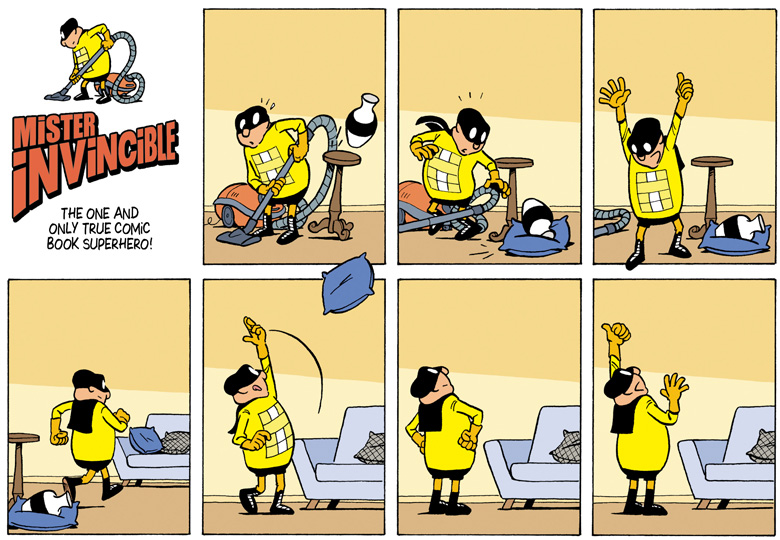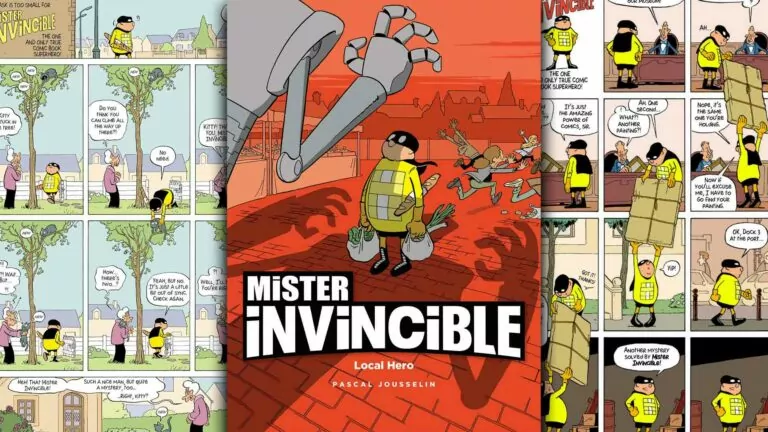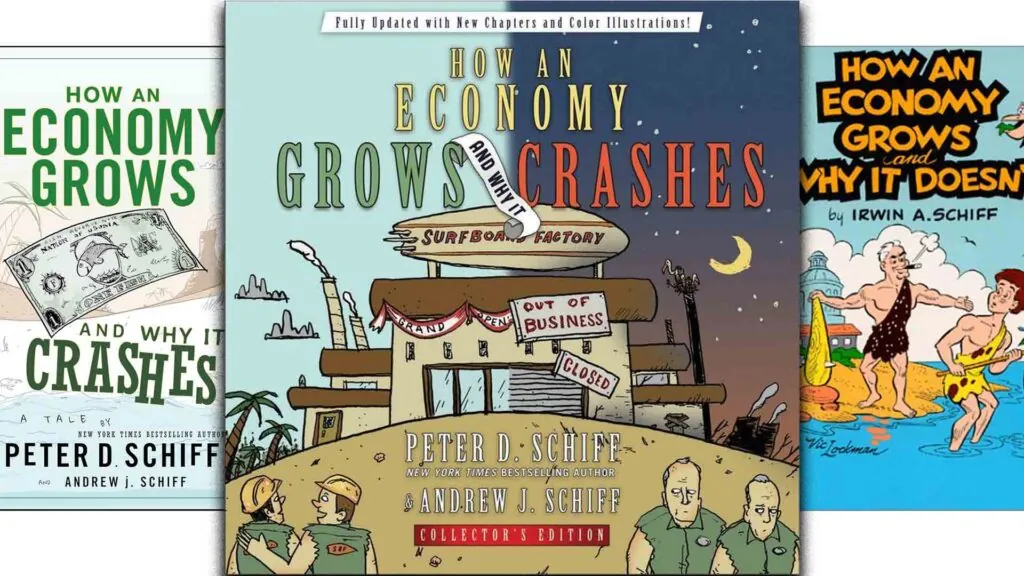by Pascal Jousselin
96 pages / 2020
My dad wasn’t a fan of superhero comics because he figured that Superman and Batman were too much like God-substitutes. And when you consider how many DC and Marvel characters are gods (Thor, Hercules, Loki, Odin, Eros) or are super-powered beings able to fight toe-to-toe with gods (Hulk, Captain Marvel, Wonder Woman, Iron Man, etc. and etc.), he might have been on to something.
But Mister Invincible is not that kind of superhero. His superpower isn’t laser beam eyes or invulnerability: he’s just the only comic book character to realize he’s in a comic book! As Gene Luen Yang explained it in his own New York Times review: “He can poke his head past the borders of his current panel to see into the future or the past. He can pass objects and even himself from one panel to another, moving through time and space.”
This is such a brilliantly original work that there’s nothing else to compare it with. And that originality makes it a hard one to properly describe. But I’m going to give it my best go.
In the opening one-page comic strip, we see Mister Invincible, in the top row of panels, look down and notice that further on down (in his future) a lady and her little boy are being robbed. So, he jumps down a row to land on one of the clueless villains. Then, to take down the second bad guy he relies on an intervention from future him, from further on down the page. Future Mister Invincible is looking up (to his past) and shoots the robber’s gun right out of his hand…. using the bad guy’s own gun, which future Mister Invincible picked up from the ground because, as we just saw in the past, the bad guy dropped it.
You might have to read that last paragraph a couple of times before it’ll start making some sense. That’s true to the comic, which also requires repeated readings to follow. Normally, that kind of confusion would make a comic annoying. But what’s different here is that it all really makes sense – it’s like a puzzle most kids will be able to decipher, but one that no one gets at their first go.
Still don’t quite get it? Let me show, rather than tell, sharing an excerpt of a couple of rows from one adventure.

I’ve handed this comic to just about everyone who’s walked into our house this last week, and for anyone under 20, it’s stopped them in their tracks. They’ve sat down and just started reading and rereading. I think a lot of adults will enjoy it too – anyone who appreciates a good logic puzzle.
Cautions
There are some minor language concerns with the bad guy calling his minions “morons,” “maggots,” and “toilet monkeys,” and a bratty kid calling one of the villains a “fat loser big butt.” Not a lot of that, but there is some.
Also, one of the villains reforms her ways from caring only about money to caring about the planet, and that care is shown with her, in just one panel, marching with environmentalists singing, “We’ve only got one planet.” True enough, but that sentiment is often used to justify policies that prioritize the planet over the people (particularly the poor) living on it.
Those two concerns are minor when the comics’ intended audience is considered. The little kids who’d titter at the juvenile insults probably wouldn’t be interested in Mister Invincible because its puzzling nature would be a bit above them.
The only other concern is a practical one. I think this is such an imaginative work it should be in every school library but, unfortunately, there is a foldout page that might not stand up well to library usage. Maybe librarians can reinforce that page ahead of time.
Conclusion
The French original is called Imbattable or “unbeatable” which is a better descriptor than “Mister Invincible.” It’s not that you can’t hurt him – he’s not invincible. It’s just that with his creative comic-crossing abilities, you can’t beat him.
And I don’t know whether you can beat this comic. It is utterly creative and so much fun to read again and again. I’d recommend it for ages 10 to 110.











